Nerežišća - natural phenomenon
In the heart of the island lies one of the strangest places in the world and home to many natural phenomenon.
Although the smallest with population, Nerežišća is an economicly growing and in addition to traditional sheep farming, the locals have turned to the development of the stone industry.
The church of Lady of Carmel dominates the place, and around it are harmonious assemblages of aristocratic houses built in stone and richly decorated. The most representative building in the settlement was the prince's palace where the prince lived with his administrative clerk. There was a prince's office, a clerk's office and a conference room, apartments for military crew and a dungeon.
In the center is the church of St. Peter and Paul, and because of its pine tree on the roof, called the Bonsai of Brač, is one of the most interesting attractions on the island of Brač and a protected monument of nature.
Not far from Nerežišća you will be surprised by the huge rock of a very unusual appearance that resembles a cake, so it is not surprising that the locals called it Koloč. An urban legend says it fulfills wishes!
To the municipalities of Nerežišća belong Murvica, Dračevica and Donji Humac.
A small village of Murvica, with vineyards and beautiful beaches is known for its desert monuments, especially for the Dragon's Cave, a miniature church in a cave with reliefs and religious figures carved.
Numerous stone houses, Roman mausoleums and statues in Donji Humac bear witness to the centuries-old tradition of stone processing. The local church with its beautiful baroque bell tower dominates the landscape of the village. Near the church there are numerous stone sculptures made at the international sculpture symposium held in Donji Humac.
The largest part of Vidova Gora extends over the area of Nerežišća and its height of 778 meters makes Brač the highest island. This is a true paradise for hunters and hikers, herbalists, adventurers. It is an attractive vantage point from which there is a view on all sides of the island of Brač and the indented coast of the island of Hvar, and sometimes even Italy.
The Blaca desert is a natural monument unique not only on Brač but also on the entire Croatian coast. It is considered a desert because of the scarcety of nature in this area. Its beginning was a stone-rebuilt cave - the first shelter of priests from Poljica. Along the steep cliff, deserted hermitages paved the church and monastery, residential and commercial buildings, and transformed the vast forests into rich vineyards and olive groves. Blaca desert, which was also an astronomical observatory, is a natural and cultural phenomenon, as well as a valuable monument to human work and persistence. The road to Blaca is a dirt path of 2 kilometers and it is intended only for walkers.The inventory of the museum includes a valuable astronomical collection of the last desert. This is one of the most visited museums on the island.
USEFUL INFORMATION
Municipalities of Nerežišća
Trg sv. Petra 5, 21423 Nerežišća
Phone: +385(0)21 637-059










































